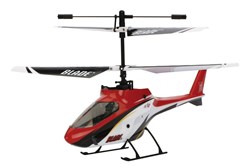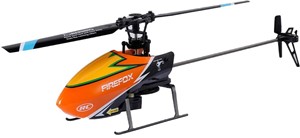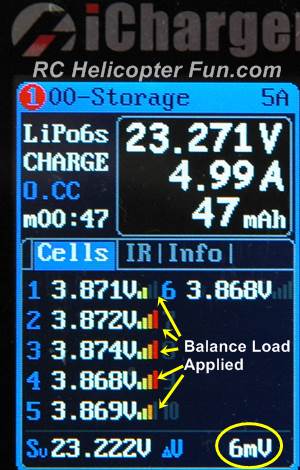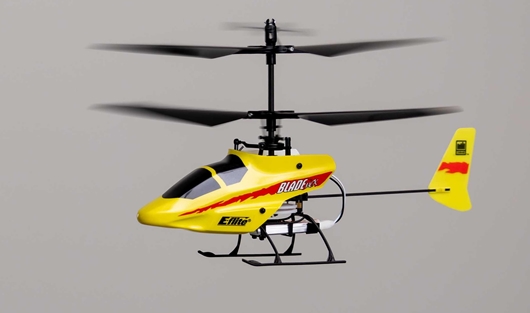RC Helicopter Auto Level
Should A Beginner Use It?
by John Salt - Last updated April 2025
Yes, we are about to dive into a polarizing topic; "should you use RC Helicopter Auto Level help when learning to fly an RC Helicopter?"
As a MAAC certified RC helicopter instructor, I'm going to give you not only my recommendations, but the reasons exactly why I, other instructors and experienced RC helicopter enthusiasts largely share the same basic opinion on this matter.
Yes, I've covered this topic elsewhere on my site and YouTube channel ad nauseum, but I'm still getting so many questions based largely on misinformation. It's time to clear this up once and for all.
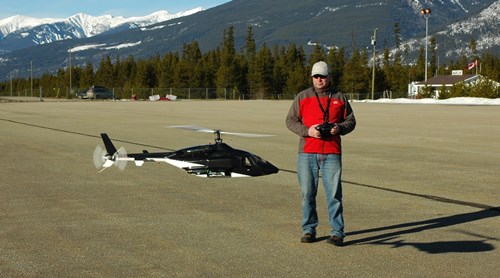 To Auto Level or Not???
To Auto Level or Not???What Is RC Helicopter Auto Level?
Auto level of course goes by many different names in the hobby these days be it Self Level, SAFE, Horizon Mode, 6G, 6 Gyro, Beginner Mode, Stability Mode and likely a few others I've not come across.
Call it what you like, the function is the same; self level uses a 6 sensor IMU (3 gyros & 3 accelerometers) in the flybarless system to auto / self-level an RC helicopter electronically when the cyclic stick (aileron/elevator) is centered.
Auto-level function when activated also prevents the helicopter from pitching or rolling past a maximum angle which is normally around 30 degrees or so; usually also limiting cyclic response/agility just like using substantial dual rate reduction on your elevator and aileron channels.
This is not the same thing as rescue or bail-out mode; well it kinda is, but both are used differently. RC helicopter auto level is turned on all the time, RC helicopter rescue mode is only used momentarily when you are getting into big trouble which I'll cover shortly.
Anyway, if this electronic stabilization auto/self level help sounds familiar or even identical to what an easy to fly micro coaxial RC helicopter or quad copter behaves like, that's exactly what it does, but on single rotor RC helicopters, be they fixed or collective pitch (3D).
In the the video below, I explain RC helicopter stabilization modes in more detail if you are still a little fuzzy on the basics.
When To Use Auto Level
Some beginners who contact me, usually combatively after reading something on my site or watching one of my videos they don't agree with, use several logical fallacies; the most common being I'm 100% against RC helicopter auto level as a training aid. That is not true!
I've been recommending super stable, self leveling RC helicopters to beginners since 2005 when they first started showing up on the market!
So many folks first started this hobby successfully back then with their very first RC helicopter being a hobby grade, 4 channel micro coaxial such as the Eflite/Blade CX, mCX, CX2 & mCX2.
Micro coaxials like these had all the same self level characteristics (mechanically achieved) as today's electronic self level stabilization systems along with true cyclic control.
I almost always recommended back in those days that total beginners with no RC heli experience, first try a ready to fly (RTF) micro coaxial like the mCX to even see if they liked flying a little egg beater around before investing in collective pitch; especially if they were self-learning.
Incidentally, the mCX was recently re-released (links to full review) as it's still a great first RC helicopter with mechanical auto-leveling. There is a very good reason it remains to be the the number one selling hobby grade micro heli of all time!
This position has not changed. These easy to fly micro coaxial RC helicopters literally changed the hobby overnight for the better, allowing so many more people to give the hobby a try without too much of an investment in time or money while also being able to have fun with their heli on day one, out of the box. Many who really enjoyed it, successfully progressed to collective pitch.
Before then, most of us had to start on large nitro powered RC helicopters that cost well into the thousands and were massively complex taking days if not weeks to build and get working.
Many a beginner failed when faced with this vertical learning curve and never even saw daylight under the skids or if they did, it was a short lived event that ended in disaster.
Anyway, I have the same newbie recommendations today with self-leveling hobby grade, 4 channel micro single rotor fixed pitch RC helicopters such as the Heli 101/C129 as my personal top RC helicopter recommendation for total beginners.
This little helicopter only has self level stabilization and it's almost as easy to fly and stable as a micro coaxial like the mCX, but it can also handle some wind which micro coaxials never could.
Micro single rotor fixed pitch RC helicopters with auto level like this are great first RC helicopters and will help you build some very important skills required to then progress to a collective pitch machine. Understanding RC helicopter controls and orientation reversals being the two most beneficial at this early stage in your RC helicopter learning curve.
So if you're just starting out, don't know much about the hobby yet and are self-learning with no instructor or experienced RC helicopter pilot to guide you, the C129/101 or any other good hobby grade, 4 channel, micro fixed pitch single rotor RC helicopter with auto level stabilization along with the Blade mCX with it's mechanical auto level is my recommendation.
Things change however once you get your first collective pitch / 3D RC helicopter.
When Not To Use Auto Level - 4 Reasons
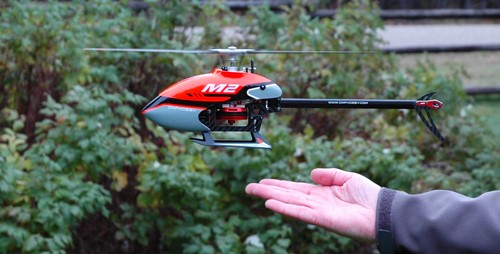 No Auto Level Here
No Auto Level HereLearning to fly a collective pitch RC helicopter is a different ball game.
They have more rotor energy while having more precise and fluid cyclic and collective (lift) responsiveness than a micro coaxial or fixed pitch heli. In other words, the feel is totally different regardless if you use self level help with them or not.
1. The main reason I and most other instructors recommend not using constant auto level help or weaning yourself off it ASAP comes down to the very first fundamental RC helicopter flying skill we all must learn - the basic tail in hover.
This is the core foundation of collective pitch RC helicopter flying that all other skills afterward are based on; at least if you want to progress and experience the type of fluid agility and control precision a good collective pitch RC helicopter is capable of, while rarely crashing.
So why and how does using self level negatively affect this fundamental tail in hover when it's fine to first use on a micro fixed pitch heli?
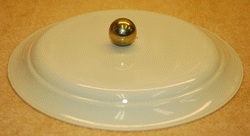 A Different Ball Game? Yes, this is what hovering a collective pitch helicopter behaves like.
A Different Ball Game? Yes, this is what hovering a collective pitch helicopter behaves like.I cover these reasons in much more detail on the aforementioned Are RC Helicopters Hard To Fly page, but this photo sums it up fairly well.
Balancing a marble on the backside of a plate. The closer the marble gets to the edge of the plate, the faster it starts accelerating off the plate; just like a collective pitch heli that is always trying to runaway/roll off the bubble of air while hovering.
This is the balancing act of hovering a collective pitch RC helicopter. Active piloting that requires many fine, nuanced command inputs you as the pilot are giving every second without even thinking about them.
The learning curve is very straight forward. It's a safe and controlled ground up learning approach with small hops off the ground becoming longer and longer in duration as all these fine motor skills are quickly developing between your eyes, brain and hands.
Before you know it, you are holding a steady hover a foot or two in the air without even thinking about or realizing all the tiny control commands you are managing. Guess what happens then? The eureka moment along with the heli addiction hits!
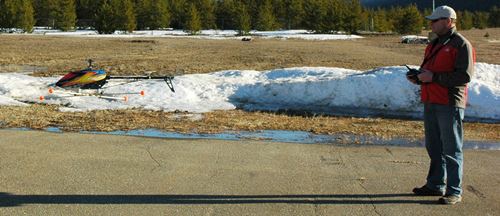 The Eureka Moment! Holding A Steady Tail In Hover. The Primary Skill All Others Are Built On & The Exact Moment Most Of Us Get Totally Hooked.
The Eureka Moment! Holding A Steady Tail In Hover. The Primary Skill All Others Are Built On & The Exact Moment Most Of Us Get Totally Hooked.It's a feeling of pride and accomplishment that most people never experience with any other form of radio control. It's why collective pitch RC helicopters are so special and so different to everything else.
With auto level turned on, all those nuanced and fine subconscious / muscle memory / hand eye coordination building skills are never developed. It's like trying to learn how to ride a bicycle or motorcycle by only practicing driving a car.
You are not only completely removed from this fun and engaging skill building process with auto level; you are also cheated out of that eureka moment.
Moreover, bad and unwanted control stick movement habits have developed and will now take more time to un-learn.
As an RC heli instructor, it's frustrating knowing some self-learners have never experienced this initial fun stage of learning to fly a collective pitch RC helicopter after contacting me, insisting I'm wrong about auto level by stating something to the effect of "only once they got an RC helicopter with auto level (or worse GPS autopilot) did they stop crashing all the time".
I respond with these two very basic probing questions: "During these initial failed attempts, had you setup your helicopter/s for learning on, and did you take the time necessary to master the tail in hover and then follow a skill building lesson plan before progressing to circuit flying?"
I usually get the exact same answer to both questions: "NO". That, or they don't even even understand those two basic questions.
I should add this is not at all like using auto level / SAFE when learning to fly an RC airplane. Most trainer RC airplanes with self level turned on still feel and behave similar to how they do while flying without auto level turned on because most trainer planes (most planes in general) are positively stable by design. Meaning, if you let go of the sticks, the airplane will continue flying in the same attitude, for a while anyway before a correction has to be made.
Not so with helicopters! Helicopters are not positively stable; they are always trying to "run away" on you as the forces of hover equilibrium are ever changing. It's a night and day difference with auto-level on or off.
2. Which brings us to the 2nd reason most instructors don't recommend auto level when learning to fly a collective pitch RC helicopter; the time it wastes - both ours and yours.
Everyone is different, but it almost always takes a student longer to un-learn unwanted stick control habits after getting used to auto level help while also now having to develop the fine hovering balancing skills they never did. Their job is basically twice as hard now and it can be very frustrating for them.
With few exceptions, people who learn without getting overly used to self level on a collective pitch RC helicopter are faster at picking up the basics and then progressing. Not only because they didn't have to re-learn the basics, but also because they are more engaged and invested in the process. In short, they are having more fun.
3. 3rd reason to learn without self level or wean yourself off it ASAP is if you belong to an RC flying club that won't give you your basic heli certification.
Rules of course are different at every flying club, but most here in Canada do require us as instructors to only sign off a student so he/she can fly without supervision after demonstrating they can safely perform all basic tail in hovering maneuvers without any self-leveling help.
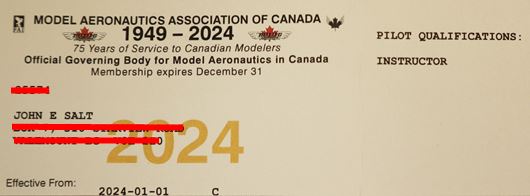 Once Signed Off - You're Good To Go :)
Once Signed Off - You're Good To Go :)4. Lastly, a correctly setup collective pitch RC helicopter for learning on will be almost as docile and forgiving to less than perfect command inputs, as one with auto level stabilization turned on. The fundamental difference however is you'll be learning & honing those core heli balancing skills every second you're in the air.
Not only making you a better and safer pilot now, but giving you the required foundation to really start enjoying what flying a collective pitch RC helicopter is all about be it scale, sport or 3D.
No you won't crash more with auto level turned off! If you learn from the ground up with a tame setup mastering the basics, most actually crash less.
The number 1 goal when learning to fly any collective pitch RC helicopter as stated in my flight school is to "always bring your bird home in one piece". This goal is not only doable for most, it's the rule rather than the exception.
In fact, I've seen beginners crash with way more energy release along with substantial helicopter damage while using auto level and GPS than when not when first starting out. Reason being, they are able to get much higher up and further away than they safely should with their current beginner skill set.
Without self level help, a collective pitch heli in the hands of a newbie who is staying close to the ground (a foot or two) and has their heli setup so it softly floats down when they panic and pull full low collective to power down, will rarely be damaged. Not always of course, but even if they do crash, damage is usually minor because there isn't as much energy release from that low altitude.
This is all instructor level understanding and reasoning that few self-learning beginners ever consider, but hopefully it clears a few things up.
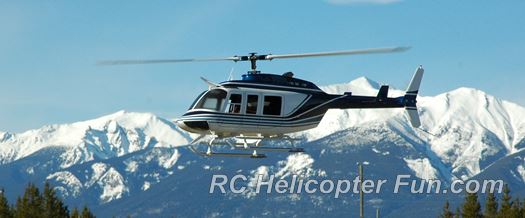 Scale RC Helicopters Behave & Fly More Like Full Size When Auto Level Is Not Used.
Scale RC Helicopters Behave & Fly More Like Full Size When Auto Level Is Not Used.RC Helicopter Auto Level Exceptions
Using auto level as a "rescue" aid is something I highly encourage!
Program self level activation to a momentary toggle/button on your transmitter to level out the heli when things are going sideways quickly. A common one we have all had is getting into some weird orientation that you likely can't regain control from. Once leveled back out, you'll have time to regain your composure, get back into a comfortable orientation and then continue flying; or land to check your underwear. Auto level rescue activation will save the day and your helicopter in such instances!
Over and above using auto/self level as a rescue feature, some people will simply never be able to fly a collective pitch RC helicopter without self level help for one reason or another; even when it's properly setup and tamed down for learning on. However, this is not common when they know what they are doing and understand the methodical, skill building ground up learning process / steps.
You may think physical or mental health challenges would be the primary reasons that hold some folks back; and while this can be the case, it applies to a small percentage of people.
The main reason comes down to lack of discipline along with the stick-to-it mind set that is required to learn basic RC helicopter hovering skills.
It's simply easier at first to use auto level; I get that. In no way am I trying to shame anyone here. Hell, I have my own lack of discipline problems. Staying away from chocolate and endeavoring to get more sleep are two I'm failing at miserably lately.
All I can offer after years of instructing experience, is for those that put in a bit of up-front effort by just taking a little extra time to learn the basic tail in hover without self level turned on, the rewards and payoffs afterward will be so worth it.
You'll be more engaged and the fun you're having will push you to practice more and more, becoming a better & safer pilot faster.
If however that is just not your cup of tea, then use auto level with your collective pitch helicopter; at least you'll be getting out and having fun with it - you know, what this hobby is all about.
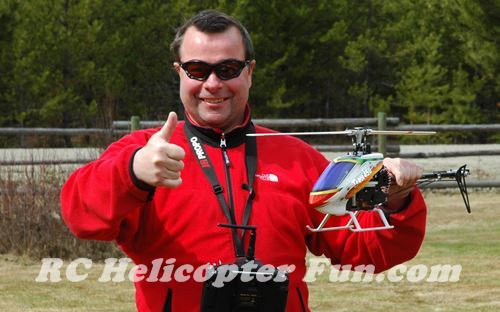 Heli Comes Home In One Piece & Having Fun
Heli Comes Home In One Piece & Having FunBut I do encourage every beginner to at least try hovering their collective pitch RC helicopter without auto-level help in conjunction with a tame setup along with training gear. Don't just take off and expect to be in control however. LEARN FROM THE GROUND UP and master your Tail In Hover!
Only resort to auto level if you just don't seem to be making any progress in your low tail in hovering exercises/lessons after several days out.
The other option is to find an instructor or experienced RC heli pilot to get that priceless one on one help both with setup & instruction.
Most importantly - have fun and fly safe :)
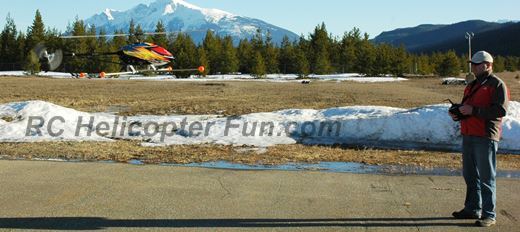 Nose In Hover Practice Time, Without Auto Level of Course - But It's There As A Rescue Aid When Disorientation Sets In :)
Nose In Hover Practice Time, Without Auto Level of Course - But It's There As A Rescue Aid When Disorientation Sets In :)